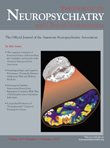Quetiapine May Be Associated With New-Onset Seizures in Patients With Seizurogenic Conditions
SIR: Quetiapine, although not studied properly, is increasingly prescribed for acute agitations in mental retardation. 1 , 2 We report on new-onset seizures in two patients receiving quetiapine.
Case Report
A 16-year-old girl was brought to the hospital by her family with symptoms of a generalized tonic-clonic (GTC) seizure. Ornithine transcarbamylase deficiency (OTCD) and mental retardation were present in past medical history. She had been diagnosed with OTCD 5 years prior, and had successfully managed on a low protein diet until the admission. Because of behavioral instability, a psychiatrist prescribed a regimen of quetiapine, 50 mg/ day 2 days, before the admission. Physical examination was normal except for delayed growth (25th percentile). Neurological examination and laboratory tests on admission were normal. Plasma ammonia was 0.78 μg/ml (normal=0.17 to 0.80 μg/ml).
We did not obtain quetiapine concentrations, as the patient had been taking quetiapine for only 2 days, making high serum concentrations unlikely. Echocardiogram (ECG), electroencephalography (EEG) and magnetic resonance imaging (MRI) of the brain were normal. The last EEG was undertaken 1 year before the event and was also normal. Special laboratory studies were done for OTCD, and a plasma amino acid profile was also normal, except for ornithine, which was high: 200 μg/ml (normal=25 to 120 μg/ml). Urine organic acid screening was also normal. From all of the findings above, we suspected that the seizures were triggered by quetiapine and we discontinued the drug. We followed up the patient for 2 weeks and she had no seizures during this period. We put her again on a regimen of quetiapine under strict control to decide whether it was the causative agent. One day after the initiation, she had a GTC seizure and the drug was immediately discontinued. Afterwards, we started her on a regimen of olanzapine. However, after 1 month of treatment with olanzapine, she had a third seizure. After this, we managed her as an outpatient without drugs for the following 11 months, and no seizures were reported.
Case Report
A 7-year-old boy who was diagnosed with autism when 3 years old and had been followed up as an outpatient since diagnosis, was admitted to the hospital because of behavioral problems. He was prescribed a regimen of quetiapine, 25 mg/ day. One day after the initiation of treatment he had a GTC seizure. We suspected that quetiapine was the causative agent and discontinued it. There was no history of predisposing factors except for autism and mental retardation. Neurological examination, laboratory tests, ECG, EEG and MRI of the brain were normal. He was followed up without any drug therapy and no seizure was reported. After 1 month of observation, we started him on a regimen of risperidone and managed him as an outpatient for the following 18 months.
Comment
Considering all factors, such as the temporal relationship between the seizure onset and quetiapine intake, the exclusion of other possible etiology of seizures and their cessation after drug withdrawal, we judged that quetiapine precipitated seizure activity in both patients. These cases serve as a reminder that postmarketing surveillance of newly released medications, clinical awareness of seizure potential when using these medications, and the need for risk factor evaluation before starting psychotropic medications are essential.
1 . Aman MG, Lindsay RL, Nash PL, et al: Individuals with mental retardation, in Pediatric Psychopharmacology Principles and Practice. Edited by Martin A, Scahill L, Charney DS, et al. New York, Oxford University Press, 2003, pp 617–630Google Scholar
2 . Cummings MR, Miller BD: Pharmacologic management of behavioral instability in medically ill pediatric patients. Curr Opin Pediatr 2004; 16:516–522Google Scholar



